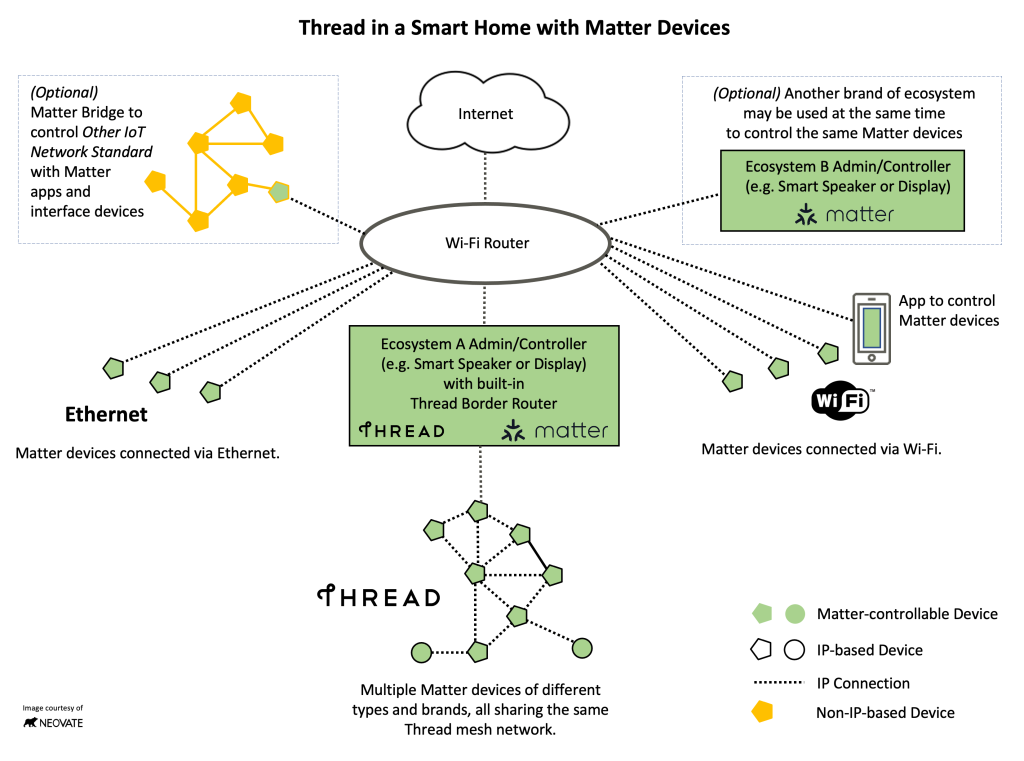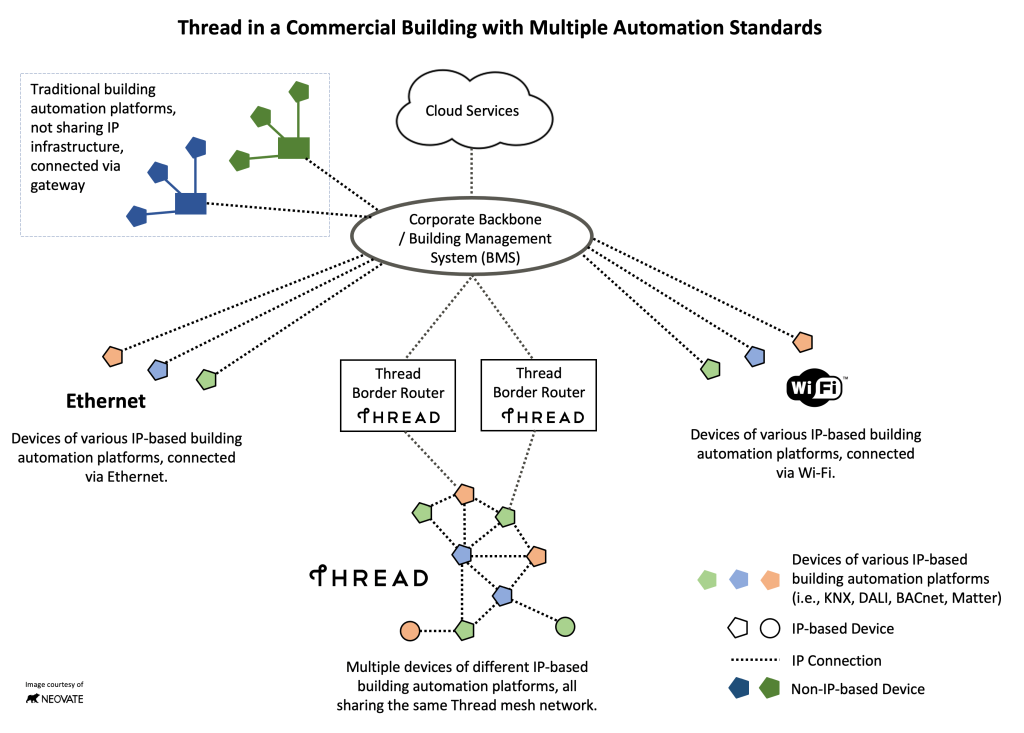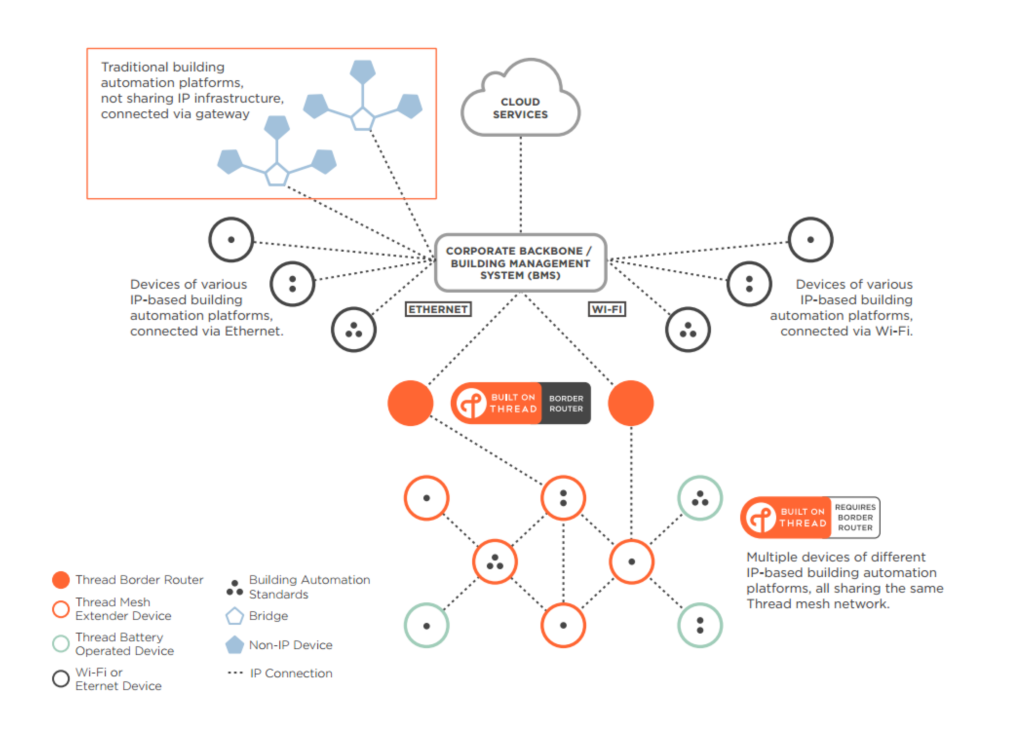
Digital transformation has been one of the main strategy topics on company board meeting agendas for the last few years. The opportunity to develop digital services from cloud-based applications requires Internet protocol (IP) based network connections to edge devices that become the customer interface. Businesses of all shapes and sizes in commercial building automation have been asking for wireless IoT solutions to make this happen.
The wait is finally over and the opportunity is right here, right now, with the launch of KNX IoT Point API (KNX IoT). This is a new addition to the suite of KNX physical transmission media. The transmission medium is IPv6 (the later Internet protocol standard) thus future-proofing KNX as it can be used on IT equipment and all common IP physical transports.
KNX Association contracted Cascoda, a-UK based IoT semiconductor and communications company, which has spent 12 years building industry-leading knowledge in this area, to develop the KNX IoT Point API open-source software stack, thereby catapulting itself into the leading wireless IoT solution for commercial building automation. The new open-source software stack is based on the robust, tried and tested Thread Mesh LPWAN wireless standard. This has been extended with banking-level security and all that is required to be a perfect product market fit for KNX users.

What is Thread?
Thread is a IPv6-based low-power wireless mesh network-layer protocol. Thread enables direct IP-based device-to-device and device-to-cloud communications. It reliably connects hundreds (or thousands) of products and includes mandatory security features. Thread mesh networks have no single point of failure, can self-heal and reconfigure when a device is added or removed, and are simple to setup and use.
Why is IP important?
IPv6 vs IPv4
With IP communications, each device has a global unique identifier called an IP address, which allows it to be uniquely addressable over the internet. There are two systems in use, namely IPv4 and IPv6. IPv4 uses a 32-bit address space, which equates to 4.3 billion, while IPv6 has a 128-bit address space which equates 340 undecillion global unique addresses. Thread uses IPv6, thus allowing seamless scalability.
IT vs OT
IP-based infrastructure is already installed in buildings and forms the IT network. IP technology has become fast enough and reliable enough to run our Operation Technology (OT) infrastructure. Since IP technology is also the basis of the internet, IP-based technology is at the heart of any digital transformation strategy.
No gateways
By contrast, non-IP based protocols require a gateway to connect to the IT network or the internet. The setup, configuration and maintenance of such gateways is complex and often requires an on-site engineer. IP-based technology however simply requires a router. IT professionals are highly proficient at setting up, configuring and maintaining IP-based equipment and tools for performing such work remotely are commonplace.
Multi-protocol support
The other major advantage of IP-based technology is that multiple applications can share the same wired or wireless IT infrastructure. This means that for example a Thread network can be installed in a building for the DALI+ lights to be configured, and the KNX IoT HVAC system can later be installed, sharing the same Thread infrastructure of routers. Such sharing of infrastructure is normally not the case with proprietary technology.
Why is wireless important?
Wireless connectivity is important because the cost of wiring-up infrastructure is costly and time-consuming. However, the most common IP-based wireless technology, Wi-Fi, has been designed for the streaming of large packets of voice and video data, rather than the occasional transmission small packets of sensor and actuator data.

Moreover, Wi-Fi is based on a star topology to each access point and even Wi-Fi mesh is based on a star-of-star topology, which limits the maximum number of nodes. Also, Wi-Fi has not been designed to support sleep-modes and it consumes too much power for long-term battery operation.
Proprietary wireless protocols have been developed to overcome many of the above issues, but they are not IP-based.
Thread mesh
Self-managing
Thread forms a self-managing, self-healing, mesh network. Thread devices can upgrade themselves to routers and downgrade to end nodes dynamically, as the needs of the network change. This allows Thread networks to be installed by unskilled professionals and minimises the need for mesh network management.
Energy efficient
Thread devices can sleep to minimise power consumption, and securely re-join the network at any time. Since Thread has been designed for sleeping and re-joining, the process is seamless and very fast, which is important for power-constrained devices.

Secure
Thread has been designed with security from the ground-up, and mandates established Internet Engineering Task Force (IETF) security standards. The use of established IETF security standards future proofs Thread against forthcoming cybersecurity standards.
Below is an example of a Building Management System (BMS), using IP-based connectivity, including Thread.
KNX IoT and Thread
The KNX IoT specification and the associated open source software stack have been developed specifically with small low-power embedded devices in mind. This means that the choices made in both the specification and the stack work very efficiently on Thread devices.
Indeed, Cascoda has implemented KNX IoT on its Thread-certified wireless modules, which run with as little as 512kB of storage memory and 96kB of memory and implemented the security with ARM® Trust zone® constructs.
Figure 2 – Cascoda’s Thread-certified wireless modules
Summary
The advantages of KNX IoT are that the new technology is IP-based and can therefore be used over IT networks. It has been developed with guaranteed interoperability with existing KNX technology, and it uses latest underlying internet-based technologies in its specification, thereby making KNX IoT secure by design.

Cascoda will shortly be releasing a KNX IoT over Thread development kit, and later a series of reference designs for particular applications. This development kit has been designed for flexibility and allows a huge range of commercially available sensors and actuators to be used, thereby covering thousands of use cases.
Bruno Johnson and Wouter van der Beek are the CEO and COO respectively of Cascoda Limited. Cascoda is a communications company that manufactures secure IoT semiconductor radios and modules, and leads the development of secure IoT communications standards for smart building and smart city. Its products solve range, reliability, security, power and scalability issues for industrial and commercial IoT through patented innovations and the latest most secure standards, all integrated into inexpensive ultra-low power IoT modules.
For More Information https://www.cascoda.com
Entelechy are Distributors and Partners for Cascoda in India. For More Information www.desiiot.com; Contact Bhavesh Doshi +91 9820629675)
Click here to read full January issue – https://www.smarthomeworld.in/magazine-january2024/















